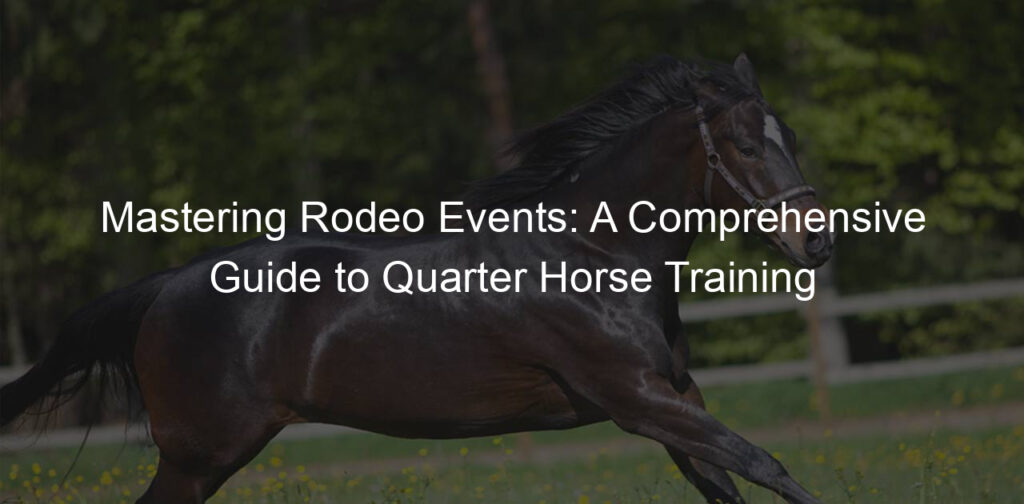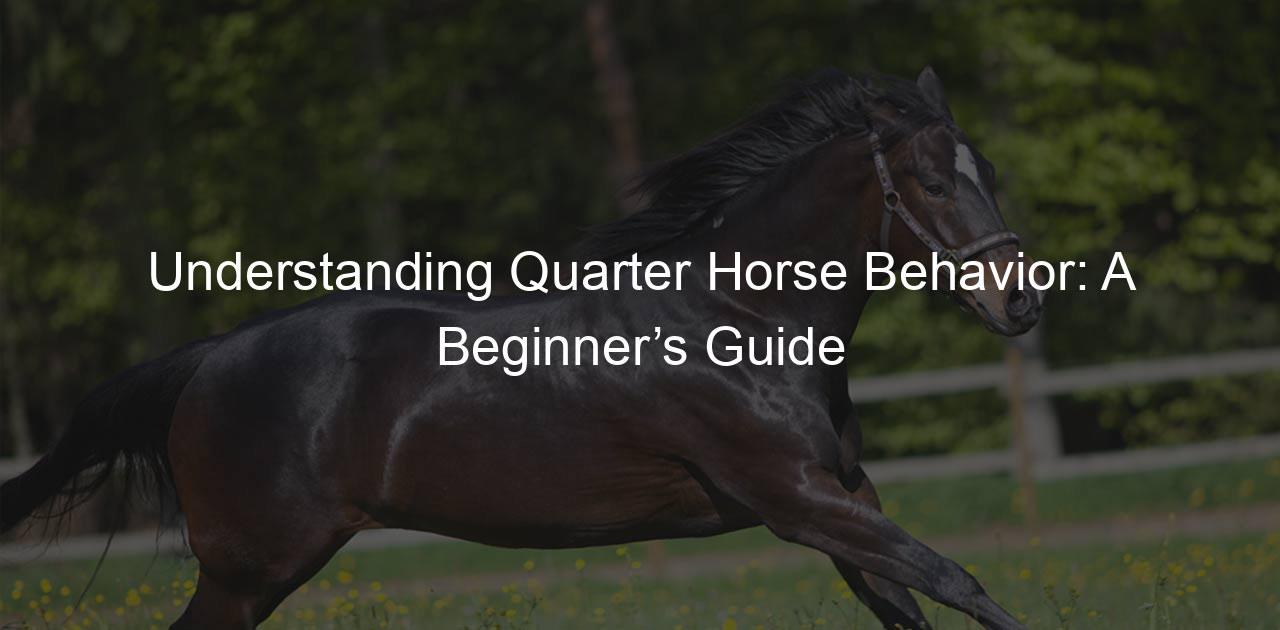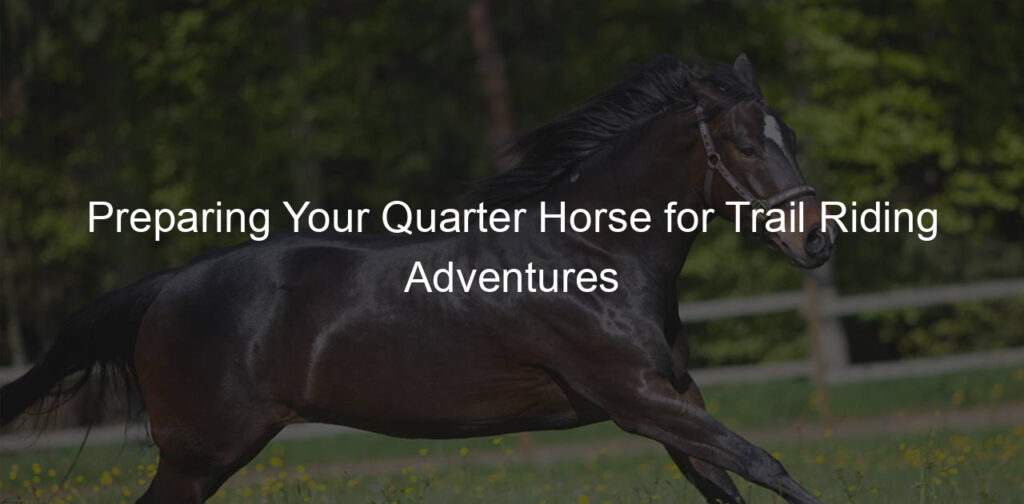Introduction to Quarter Horse Training
Welcome to the exciting world of Quarter Horse training! Whether you’re a horse lover, a rodeo enthusiast, or just curious about this fascinating breed, we’re here to guide you through the basics and beyond.
- Understanding the importance of Quarter Horse training
- Basics of Rodeo events training
Training a Quarter Horse is not just about teaching it to follow commands. It’s about building a bond of trust and understanding between you and your horse. A well-trained Quarter Horse is a joy to ride, and can excel in a variety of disciplines, from rodeo events to trail riding. They’re known for their speed, agility, and intelligence, which makes them perfect for competitive events. But these qualities also mean they need consistent, quality training to reach their full potential.
Training a Quarter Horse for rodeo events can be a thrilling journey. Rodeo events like barrel racing, pole bending, and roping require a horse to be quick, agile, and responsive. The basics of rodeo training involve teaching your horse to respond to your cues quickly and accurately, building their physical strength and endurance, and helping them develop the confidence to perform in a high-pressure environment. Remember, every horse is unique, so it’s important to tailor your training to your horse’s individual strengths and weaknesses.
Training a Quarter Horse can be a rewarding experience, but it’s also a big responsibility. It requires time, patience, and a deep understanding of horse behavior. But don’t worry, we’re here to help you every step of the way. So saddle up, and let’s get started on this amazing journey!
Training Horses for Rodeo: Getting Started
Training a horse for rodeo is a thrilling journey that requires patience, dedication, and a deep understanding of the horse’s capabilities. The first step in this exciting adventure is choosing the right horse, specifically a Quarter Horse, known for their agility and speed.
Choosing the Right Quarter Horse
When it comes to rodeo, not all horses are created equal. The Quarter Horse, with its muscular build and quick reflexes, has proven to be a champion in the rodeo arena. But what should you look for when choosing your Quarter Horse for rodeo training? Let’s dive in!
- Characteristics of a Good Rodeo Horse
- Understanding Quarter Horse Rodeo Performance
A good rodeo horse is more than just a pretty face. They need to have a strong build, quick reflexes, and a calm demeanor. They should be agile, able to change direction quickly, and have a good sense of balance. A good rodeo horse should also be brave and not easily spooked, as rodeo events can be loud and chaotic. A horse with these characteristics will be able to perform well in the rodeo arena.
Quarter Horses are known for their speed and agility, which makes them perfect for rodeo events. They excel in events like barrel racing, where they need to navigate a course of barrels at high speed. They’re also great at roping events, thanks to their quick reflexes and ability to stop and turn on a dime. Understanding these abilities can help you choose the right Quarter Horse for your rodeo training.
Choosing the right Quarter Horse for rodeo training is a crucial first step in your rodeo journey. By understanding the characteristics of a good rodeo horse and the performance abilities of the Quarter Horse, you can make an informed decision and choose a horse that will be a true rodeo champion.
Essential Equipment for Rodeo Horse Preparation
When it comes to preparing your Quarter Horse for a rodeo, there are two pieces of equipment that are absolutely essential: the saddle and the horseshoes. Let’s take a closer look at why these items are so important and how to choose the right ones for your horse.
- Choosing the right saddle
The saddle is more than just a seat for the rider; it’s a vital piece of equipment that can significantly affect your horse’s performance. A good saddle provides comfort and stability, allowing your horse to move freely and perform at their best.
When choosing a saddle, consider the following factors:
- Fit: The saddle should fit both the rider and the horse. An ill-fitting saddle can cause discomfort or even injury.
- Material: Look for a saddle made from high-quality, durable materials. Leather is a popular choice due to its durability and comfort.
- Design: The design of the saddle should suit the specific demands of rodeo events. For example, a barrel racing saddle is designed to allow the horse maximum freedom of movement.
- Importance of proper horseshoes
Horseshoes are another essential piece of equipment for rodeo horses. They protect the horse’s hooves from damage, provide traction, and can even enhance performance in certain events.
When choosing horseshoes, consider the following factors:
- Size and fit: Just like with a saddle, the fit of the horseshoes is crucial. They should be the right size for your horse’s hooves and fitted by a professional farrier.
- Material: Horseshoes can be made from various materials, including steel, aluminum, and even plastic. The best material for your horse depends on the specific demands of the rodeo events they’ll be participating in.
- Type: There are different types of horseshoes designed for different purposes. For example, sliding plates are used for reining events, while traction shoes are used for barrel racing.
Remember, the right equipment can make a huge difference in your horse’s performance. So take the time to choose the right saddle and horseshoes for your Quarter Horse.
Quarter Horse Coaching: Techniques and Strategies
When it comes to Quarter Horse coaching, there are a few techniques and strategies that can help your horse excel in rodeo events. Let’s take a closer look at some of these techniques.
Rodeo Event Horse Training Techniques
Rodeo events require a unique set of skills from both the horse and the rider. Here are some training techniques that can help your Quarter Horse shine in these events:
- Training techniques for barrel racing: Barrel racing is all about speed and agility. Start by introducing your horse to the barrels in a non-threatening way. Let them sniff and touch the barrels. Gradually, start walking your horse around the barrels in a cloverleaf pattern. As your horse gets comfortable, increase the speed. Remember, consistency is key. Practice the pattern regularly but also give your horse plenty of breaks to avoid stress and fatigue.
- Training techniques for roping: Roping requires precision and timing. Start by getting your horse used to the rope. Swing it around them without throwing it. Once they’re comfortable, practice throwing the rope at a dummy target while mounted. Make sure your horse is steady and calm before, during, and after you throw the rope. Gradually, introduce live cattle into the mix. Remember, patience and repetition are crucial in roping training.
Remember, every horse is unique and what works for one might not work for another. Always pay attention to your horse’s comfort and stress levels during training. Happy training!
Professional Quarter Horse Training Tips
Hey there, horse lovers! Today, we’re going to talk about some super important tips for training your Quarter Horse. These tips are used by professionals, so you know they’re good. But don’t worry, we’ll explain everything in a way that’s easy to understand. Let’s get started!
- Importance of consistent training schedule
Just like us humans, horses need a routine. They like to know what’s coming next. So, it’s super important to have a consistent training schedule. This means training at the same time every day. It helps your horse to understand what’s expected of them and makes the training process smoother.
Did you know that a study from the University of Kentucky found that horses trained on a consistent schedule performed better than those with irregular schedules? That’s a pretty cool fact, right?
- Benefits of professional coaching
Now, let’s talk about professional coaching. You might be thinking, “I can train my horse on my own, why do I need a coach?” Well, a professional coach can help you in ways you might not have thought of.
A coach can spot things you might miss and give you new techniques to try. They can also help you understand your horse better. Plus, a coach can give you a fresh perspective and help you overcome any challenges you might be facing. Remember, even the best athletes in the world have coaches!
According to a survey by the American Quarter Horse Association, 85% of horse owners who used a professional coach saw improvements in their horse’s performance. That’s a lot of happy horses and owners!
So there you have it, folks! Two professional tips for training your Quarter Horse. Remember, consistency is key and don’t be afraid to ask for help. Happy training!
Training Quarter Horses for Competition
Training a Quarter Horse for competition is a thrilling journey. It involves a lot of hard work, patience, and dedication. But don’t worry, we’re here to guide you through it!
Preparing Your Horse for Rodeo Events
When it comes to rodeo events, preparation is key. And not just any preparation, but a balanced mix of physical and mental preparation. Let’s dive into what each of these entails:
- Physical preparation: This is all about getting your horse in tip-top shape. Regular exercise is crucial. This could include long rides, sprints, and agility training. Remember, your horse’s diet plays a big role too. A balanced diet ensures your horse has the energy it needs to train and compete. Always consult with a vet or a horse nutrition expert to make sure your horse’s diet is on point.
- Mental preparation: This is just as important as physical preparation. A horse that’s mentally prepared is calm, focused, and ready to take on any challenge. You can help your horse achieve this state through consistent training, positive reinforcement, and by creating a calm, stable environment. It’s also important to gradually expose your horse to different scenarios it might encounter in a rodeo. This could include loud noises, crowds, and other horses.
Remember, every horse is unique. What works for one might not work for another. So, always be patient, observe your horse closely, and adjust your training methods as needed. Happy training!
Rodeo Quarter Horse Techniques: Case Studies
Let’s dive into some real-life examples of Quarter Horse techniques used in rodeo events. These case studies will give you a better understanding of how these techniques are applied in actual competitions.
- Case study: Successful barrel racing techniques
- Case study: Effective roping techniques
Meet Sally, a seasoned rodeo competitor who has been barrel racing with her Quarter Horse, Thunder, for over five years. Sally has a unique approach to training Thunder for barrel racing. She focuses on building Thunder’s agility and speed through a variety of exercises, including weaving through poles and sprinting short distances.
One of Sally’s key strategies is to practice the barrel racing pattern in reverse. This helps Thunder to anticipate the turns and increases his speed during the actual race. Sally’s technique has proven to be successful, with Thunder winning several local and state competitions.
You can read more about barrel racing techniques on Wikipedia.
Next, let’s look at John, a professional roper who has been competing with his Quarter Horse, Lightning, for over a decade. John’s roping technique involves a combination of precision, timing, and teamwork between him and Lightning.
John spends a lot of time training Lightning to respond to subtle cues. This allows them to work together seamlessly during the roping event. John also practices his lassoing skills regularly, aiming for accuracy and speed. His hard work has paid off, with numerous roping titles to his name.
For more information on roping techniques, check out this Wikipedia page.
These case studies highlight the importance of specialized training and techniques in rodeo events. With the right approach and dedication, you too can achieve success with your Quarter Horse in rodeo competitions.
Conclusion: Mastering Rodeo Events with Quarter Horse Training
It’s been a thrilling ride, hasn’t it? We’ve galloped through the basics of Quarter Horse training, learned how to get started with rodeo training, and even explored some advanced coaching techniques. Now, as we approach the finish line, let’s recap some key takeaways and resources for your continued learning journey.
- Key takeaways for successful Quarter Horse training
Training a Quarter Horse for rodeo events is no small feat. It requires patience, dedication, and a deep understanding of the horse’s unique strengths and weaknesses. Here are some key points to remember:
- Start with the basics: Before you can train a horse for complex rodeo events, you need to master basic horsemanship skills. This includes understanding horse behavior, learning how to handle a horse safely, and building a strong bond of trust with your horse.
- Consistency is key: Horses learn best through repetition. Be consistent in your training routines and commands to help your horse understand what you’re asking of them.
- Patience pays off: Training takes time. Don’t rush the process. Celebrate small victories and keep working towards your goals.
- Health and wellbeing: A healthy horse is a happy horse. Regular vet check-ups, a balanced diet, and plenty of exercise are essential for your horse’s performance.
- Continuing education and resources
Learning never stops, especially in the dynamic world of rodeo. Here are some resources to help you continue your education:
- American Quarter Horse Wikipedia Page: This page provides a wealth of information about the history, characteristics, and uses of the American Quarter Horse.
- Rodeo Wikipedia Page: Learn more about the sport of rodeo, its history, and the different events involved.
Remember, the journey to mastering rodeo events with Quarter Horse training is a marathon, not a sprint. Keep learning, keep practicing, and most importantly, have fun along the way!









